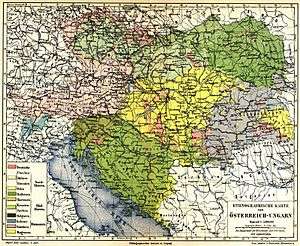North Slavic languages
.png)

The term North Slavic languages (or North Slavonic languages) has three meanings.
North versus South Slavic

It is sometimes (albeit not very often) used to combine the West Slavic and the East Slavic languages into one group, (much like South Germanic languages combining the North, West and East Germanic branches) due to the fact that the Southern Slavic dialects were geographically cut off by the Hungarian settlement of the Pannonian plain in the 9th century along with Austria and Romania being geographical barriers. Due to this geographical separation, the North Slavs and South Slavs developed apart from each other with noteworthy cultural differences.
North Slavic peoples today include the Belarusians, Czechs, Kashubians, Poles, Silesians, Rusyns, Russians, Slovaks, Sorbs, and Ukrainians. They inhabit a contiguous area in Central and Eastern Europe and North Asia.
The greatest disparities are between South Slavic tongues and the rest of the Slavonic languages.[1][2][3][4] Moreover, there are many exceptions and whole dialects that break the division of East and West Slavic languages; thus the Slavs are clearly divided into two main linguistic groups: the North Slavs and the South Slavs, which can then be further categorised as the Northwest tongues (Czech, Kashubian, Polish, Silesian, Slovak, and Sorbian) and the Northeast ones (Belarusian, Russian, Rusyn, and Ukrainian) – whereas the Southern branch is split into the widely accepted groups of the Southwest languages (Serbo-Croatian and Slovene) and the Southeast tongues (Bulgarian and Macedonian).[2] This model is argued as being more appropriate than the triple dissection of east, west and south.
Much overlap can be found between the Northwest and Northeast branches. Ukrainian and Belarusian have both been hugely influenced by Polish in the past centuries thanks to their geographic and cultural proximity, as well as some efforts at Polonising the Ruthenian population of the Polish Commonwealth.[2] Professor Michał Łesiów once said that "there are no two languages in the Slavic area that were as equally close to each other as Polish and Ruthenian".[5] According to Kostiantyn Tyshchenko, Ukrainian shares 70% common vocabulary with Polish and 66% with Slovak, which puts them both ahead of Russian (at 62%) in their lexical proximity to Ukrainian.[6] Furthermore, Tyschenko identified 82 grammatical and phonetic features of the Ukrainian tongue – Polish, Czech and Slovak share upwards of 20 of these characteristics with Ukrainian, whereas Russian apparently only 11.[7]
In contrast to other dialects of Slovak, Eastern dialects (sometimes called Slovjak) are less intelligible with Czech and more with Polish and Rusyn.[8]
An extinct branch of Slavic
Anatoli Zhuravlyov suggested that a separate, now extinct, branch of North Slavic languages once existed, different from both South, West, and East Slavic. The dialect formerly spoken in the vicinity of Novgorod (the Old Novgorod dialect) contains several Proto-Slavic archaisms that did not survive in any other Slavic language, and may be considered a remnant of an ancient North Slavic branch.[9]
Constructed North Slavic languages
There is a group of artistic languages forming a fictional North Slavic branch of the Slavic languages. The best-known examples of constructed North Slavic languages are: Sevorian (Sievrøsku), Nassian (Nassika), Seversk, Slavëni, and Vozgian.[10]
References
- ↑ Kamusella, Tomasz; Nomachi, Motoki; Gibson, Catherine (2016). The Palgrave Handbook of Slavic Languages, Identities and Borders. London: Palgrave Macmillan. ISBN 9781137348395.
- 1 2 3 Serafin, Mikołaj (January 2015). "Cultural Proximity of the Slavic Nations" (PDF). Retrieved April 28, 2017.
- ↑ Živković, Tibor; Crnčević, Dejan; Bulić, Dejan; Petrović, Vladeta; Cvijanović, Irena; Radovanović, Bojana (2013). The World of the Slavs: Studies of the East, West and South Slavs: Civitas, Oppidas, Villas and Archeological Evidence (7th to 11th Centuries AD). Belgrade: Istorijski institut. ISBN 8677431047.
- ↑ Lindsay, Robert. "Mutual Intelligibility of Languages in the Slavic Family" (docx). Retrieved April 29, 2017.
- ↑ Łesiów, M. (2011). In: Łabowicz, L. (ed.) Gdzie "sicz", a gdzie "porohy"?!. In: Над Бугом і Нарвою, Iss. 117, p. 15.
- ↑ Tyschenko, Kostiantyn. "Мови Європи: відстані між мовами за словниковим складом". Retrieved April 29, 2017.
- ↑ Tyshchenko, K. (2012). Правда про походження української мови. In: Lytvynenko, S (ed.) Український тиждень, Iss. 39, p. 35.
- ↑ Štolc, Jozef (1994). Slovenská dialektológia [Slovak dialectology]. Bratislava: Veda.: Ed. I. Ripka.
- ↑ А. Ф. Журавлев, "Лексико-статистическое моделирование системы славянского языкового родства", Moscow, 1994, p. 63.
- ↑ Tilman Berger, Vom Erfinden Slavischer Sprachen, in: M. Okuka & U. Schweier, eds., Germano-Slavistische Beiträge. Festschrift für P. Rehder zum 65. Geburtstag, München 2004, pp. 19-28 (in German).
- Bernard Comrie & Greville G. Corbett, The Slavonic languages (London, 1993), pp. 75 & 115-119.
- Andrii Danylenko, 2006, "The 'Greek Accusative' vs. the 'New Slavic Accusative' in the Impersonal Environment: an Areal or Structural Discrepancy?", in: Andrii Danylenko, "Slavica et Islamica. Ukrainian in Context". München: Otto Sagner Verlag, 243-265.
- Marc L. Greenberg, Uralic Influences in South Slavic
- Arne Hult, "On the verbal morphology of the South Slavic languages (in comparison with the North Slavic languages, especially Russian", Papers from First Conference on Formal Approaches to South Slavic Languages. Plovdiv October 1995. Dragvoll, University of Trondheim, Linguistics Department (= University of Trondheim. Working Papers in Linguistics 28), ss. 105-35. (23)
- Frederik Kortlandt, "Early dialectal diversity in South Slavic II", in: Dutch Contributions to the Thirteenth International Congress of Slavists, Ljubljana: Linguistics (SSGL 30). Amsterdam – New York: Rodopi, 2003, 215-235.
- Frederik Kortlandt, From Proto-Indo-European to Slavic
- Gilbert C. Rappaport, "A Minimalist Approach to Case Marking in Slavic"
- Alan Timberlake, 1978, "On the History of the Velar Phonemes in North Slavic" [in Russian with English synopsis]. In Henrik Birnbaum, ed., American Contributions to the Eighth International Congress of Slavists, vol. 1, Linguistics and Poetics. Columbus, OH: Slavica Publishers.
- Hannu Tommola, 2000, "On the Perfect in North Slavic." Östen Dahl (ed.), Tense and Aspect in the Languages of Europe. Berlin: Mouton de Gruyter, 441-478.
External links
- "Sevorian" artificially constructed language
- "Nassian" artificially constructed language
- "Vozgian" artificially constructed language
- "Novegradian" artificially constructed language